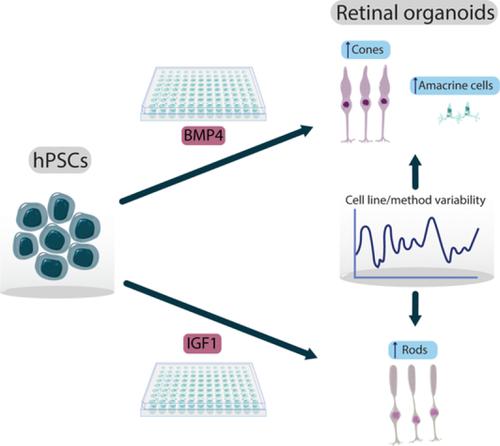当前位置:
X-MOL 学术
›
STEM CELLS
›
论文详情
Our official English website, www.x-mol.net, welcomes your feedback! (Note: you will need to create a separate account there.)
Human iPSC differentiation to retinal organoids in response to IGF1 and BMP4 activation is line- and method-dependent
STEM CELLS ( IF 5.2 ) Pub Date : 2019-12-30 , DOI: 10.1002/stem.3116 Valeria Chichagova 1 , Gerrit Hilgen 2 , Ali Ghareeb 3 , Maria Georgiou 3 , Madeleine Carter 3 , Evelyne Sernagor 2 , Majlinda Lako 3 , Lyle Armstrong 1, 3
STEM CELLS ( IF 5.2 ) Pub Date : 2019-12-30 , DOI: 10.1002/stem.3116 Valeria Chichagova 1 , Gerrit Hilgen 2 , Ali Ghareeb 3 , Maria Georgiou 3 , Madeleine Carter 3 , Evelyne Sernagor 2 , Majlinda Lako 3 , Lyle Armstrong 1, 3
Affiliation

|
Induced pluripotent stem cell (iPSC)‐derived retinal organoids provide a platform to study human retinogenesis, disease modeling, and compound screening. Although retinal organoids may represent tissue structures with greater physiological relevance to the in vivo human retina, their generation is not without limitations. Various protocols have been developed to enable development of organoids with all major retinal cell types; however, variability across iPSC lines is often reported. Modulating signaling pathways important for eye formation, such as those involving bone morphogenetic protein 4 (BMP4) and insulin‐like growth factor 1 (IGF1), is a common approach used for the generation of retinal tissue in vitro. We used three human iPSC lines to generate retinal organoids by activating either BMP4 or IGF1 signaling and assessed differentiation efficiency by monitoring morphological changes, gene and protein expression, and function. Our results showed that the ability of iPSC to give rise to retinal organoids in response to IGF1 and BMP4 activation was line‐ and method‐dependent. This demonstrates that careful consideration is needed when choosing a differentiation approach, which would also depend on overall project aims.
中文翻译:

响应 IGF1 和 BMP4 激活的人类 iPSC 分化为视网膜类器官是线和方法依赖性的
诱导多能干细胞 (iPSC) 衍生的视网膜类器官为研究人类视网膜生成、疾病建模和化合物筛选提供了一个平台。尽管视网膜类器官可能代表与体内人类视网膜具有更大生理相关性的组织结构,但它们的产生并非没有限制。已经开发了各种协议来开发具有所有主要视网膜细胞类型的类器官;然而,经常报告 iPSC 系之间的变异性。调节对眼睛形成很重要的信号通路,例如涉及骨形态发生蛋白 4 (BMP4) 和胰岛素样生长因子 1 (IGF1) 的信号通路,是体外生成视网膜组织的常用方法。我们使用三种人类 iPSC 系通过激活 BMP4 或 IGF1 信号传导来生成视网膜类器官,并通过监测形态变化、基因和蛋白质表达以及功能来评估分化效率。我们的结果表明,iPSC 产生响应 IGF1 和 BMP4 激活的视网膜类器官的能力是线和方法依赖性的。这表明在选择差异化方法时需要仔细考虑,这也取决于整体项目目标。
更新日期:2019-12-30
中文翻译:

响应 IGF1 和 BMP4 激活的人类 iPSC 分化为视网膜类器官是线和方法依赖性的
诱导多能干细胞 (iPSC) 衍生的视网膜类器官为研究人类视网膜生成、疾病建模和化合物筛选提供了一个平台。尽管视网膜类器官可能代表与体内人类视网膜具有更大生理相关性的组织结构,但它们的产生并非没有限制。已经开发了各种协议来开发具有所有主要视网膜细胞类型的类器官;然而,经常报告 iPSC 系之间的变异性。调节对眼睛形成很重要的信号通路,例如涉及骨形态发生蛋白 4 (BMP4) 和胰岛素样生长因子 1 (IGF1) 的信号通路,是体外生成视网膜组织的常用方法。我们使用三种人类 iPSC 系通过激活 BMP4 或 IGF1 信号传导来生成视网膜类器官,并通过监测形态变化、基因和蛋白质表达以及功能来评估分化效率。我们的结果表明,iPSC 产生响应 IGF1 和 BMP4 激活的视网膜类器官的能力是线和方法依赖性的。这表明在选择差异化方法时需要仔细考虑,这也取决于整体项目目标。


























 京公网安备 11010802027423号
京公网安备 11010802027423号